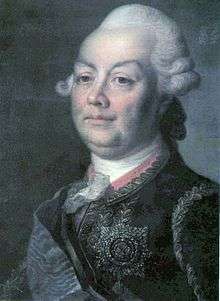Pyotr Rumyantsev
| Count Pyotr Rumyantsev Zadunaisky | |
|---|---|
 | |
| Governor of Little Russia | |
|
In office 1764–1786 | |
| Preceded by | Kyrylo Rozumovsky (as the Hetman of Zaporizhian Host) |
| Succeeded by | office liquidated |
| Personal details | |
| Born |
15 January 1725 Moscow, Russian Empire |
| Died |
19 December 1796 (aged 71) Pereyaslav county, Little Russian Governorate, Russian Empire |
| Military service | |
| Allegiance |
|
| Service/branch | Imperial Russian Army |
| Rank | Field Marshal |
| Battles/wars |
Pomeranian War Russo-Turkish War (1768–74) Russo-Turkish War (1787–92) |
Count Pyotr Alexandrovich Rumyantsev-Zadunaisky (Russian: Пётр Александрович Румянцев-Задунайский) (15 January 1725 – 19 December 1796) was one of the foremost Russian generals of the 18th century. He governed Little Russia in the name of Empress Catherine the Great from the abolition of the Cossack Hetmanate in 1764 until Catherine's death 32 years later. Monuments to his victories include Kagul Obelisk in Tsarskoe Selo (1772), Rumyantsev Obelisk on Basil Island (1798–1801), and a galaxy of Derzhavin's odes.
Early life
Peter was the only son of Count Alexander Rumyantsev by Maria, the daughter and heiress of Count Andrey Matveyev. As his mother spent much time in the company of Peter the Great, rumours suggested that the young Rumyantsev was the monarch's illegitimate son. He was named after the ruling Emperor who was his godfather. He was the brother of Praskovya Bruce, confidant of Catherine the Great.
Pyotr Alexandrovich first saw military service under his nominal father in the war with Sweden (1741 - 1743). He personally carried to the Empress the peace treaty of Abo, concluded by his father in 1743. Thereupon he gained promotion to the rank of colonel.
His first military glory dates from the great battles of the Seven Years' War (1756 - 1763), those of Gross-Jägersdorf (1757) and Kunersdorf (1759). In 1761 he besieged and took the Pomeranian fortress of Kolberg, thus clearing for Russian armies the path to Berlin.
First Russo-Turkish War

Throughout the reign of Catherine the Great, Rumyantsev served as supreme governor of Ukraine. In this post, which his father had held with so much honesty, Rumyantsev made it his priority to eliminate any autonomy of the hetmans and to fully incorporate the newly conquered territories into the Russian Empire. Some accuse him of having promoted serfdom in New Russia, but the choice of such a policy remained out of his control.
With the outbreak of the Russo-Turkish war in 1768, Rumyantsev took command of the army sent to capture Azov. He thoroughly defeated the Turks in the Battles of Larga and Kagula, crossed the Danube and advanced to Romania. For these dazzling victories he became Field-Marshal and gained the victory title Zadunaisky (meaning "Trans-Danubian"). When his forces approached Shumla in 1774, the new Sultan Abdul Hamid I started to panic and sued for peace, which Rumyanstev signed upon a military tambourine at the village of Kuchuk-Kainarji.
Second Russo-Turkish War
By that point, Rumyantsev had undoubtedly become the most famous Russian commander. Other Catharinian generals, notably Potemkin, allegedly regarded his fame with such jealousy that they wouldn't permit him to take the command again. In times of peace, Rumyantsev expressed his innovative views on the martial art in the Instructions (1761), Customs of Military Service (1770), and the Thoughts (1777). These works provided a theoretical base for the re-organisation of the Russian army undertaken by Potemkin.
During the Second Russo-Turkish War, Rumyantsev suspected Potemkin of deliberately curtailing supplies of his army and presently resigned his command. In the Polish campaign of 1794 he once again won appointment as commander-in-chief, but his rival Suvorov actually led the armies into battle. On this occasion Rumyantsev didn't bother even to leave his Ukrainian manor at Tashan which he had rebuilt into a fortress. He died there on December 19, 1796, just over a month after Catherine's death, and was interred in the Kiev Pechersk Lavra.
 |
 | |||||
| Kachanovka Palace, Ukraine. | Governors' Palace in Kiev. | Rumyantsev Residence in Gomel, Belarus. | Nikolai Rumyantsev's mansion on English Quay, St. Petersburg. |
As the story goes, old Rumyantsev-Zadunaisky grew enormously fat and avaricious, so that he pretended not to recognize his own sons when they came from the capital to ask for money. Under his son Sergey's administration, Tashan fell into ruins, although he erected a mausoleum near Balashikha for his father's reburial (which never took place). Neither Sergey nor his brother Nikolay Petrovich Rumyantsev married, and the comital branch of the Rumyantsev family went extinct upon their death.
See also
| Wikimedia Commons has media related to Pyotr Alexandrovich Rumyantsev-Zadunaisky. |
References
![]() This article incorporates text from a publication now in the public domain: Chisholm, Hugh, ed. (1911). Encyclopædia Britannica (11th ed.). Cambridge University Press.
This article incorporates text from a publication now in the public domain: Chisholm, Hugh, ed. (1911). Encyclopædia Britannica (11th ed.). Cambridge University Press.
| Government offices | ||
|---|---|---|
| Preceded by Kyrylo Rozumovsky as Hetman of Zaporizhian Host |
Governor-General of Little Russia 1764–1789 |
Succeeded by Mikhail Krechetnikov |
|